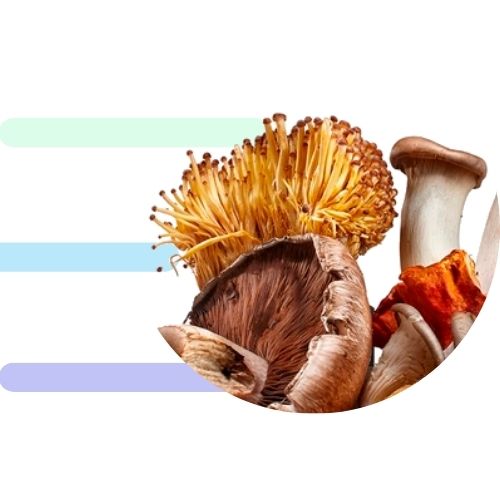“So, tell me all about all the different types of mushrooms!” the newly-minted mycophile enthuses. More experienced mushroom-geeks smile indulgently. There are thousands of species of mushrooms out there. No, we can’t tell you all about all of them.
But there is no reason why “type” has to mean “species.” There are larger orders of organization, other ways to get an overview of all things mushroom. It’s an intricate and fascinating world out there, and a quick introduction to that world will help you make more sense of what you do learn about particular mushroom species. So come on—we’ll give you a tour.
What is a Mushroom?
The answer to the question, what is a mushroom, may seem obvious. We’ve all seen the white buttons in the grocery stores or on pizzas. Most of us have seen vaguely similar-looking things growing in lawns or out of dead trees and so forth. Those, and things like them, are mushrooms. But the truth is not that simple. Is a Chanterelle a mushroom? It is anatomically very different from a white button, after all. What about a Puffball? Or a Dog-Nose Fungus? Or one of those crusts that grow over logs? What is a mushroom?
There’s even more than one way to answer the question.
What Is Taxonomy?
In order for this discussion to make sense, we need to introduce you to the taxonomic system—some of you may know this system already, while others may find even the name intimidating. If you’re among the latter, don’t worry. There’s just a little bump of a learning curve, then all sorts of other things get much easier. Earlier, we referred to mushrooms as a “world.” Well, taxonomy is the map to that world.
“Taxonomy” basically means “naming things.” It’s a system or structure where little categories fit into bigger categories, which fit into even bigger categories, and so on. All of life fits into the system somewhere. The smallest category is the species (actually, smallest is subspecies, but let’s keep things simple for now). The largest—last we checked, anyway—is kingdom. Here are the major categories in order, smallest to largest:
Species
Genus (plural: genera)
Family
Order
Class
Phylum (plural: phyla)
Kingdom
Remember the order with this fun mnemonic: King Philip Came Over For Grandma’s Soup.
The “scientific name” is the genus and the species epithet together. Here’s how taxonomy looks for a familiar species, a wolf (Canis lupus):
Species: lupus
Genus: Canis
Family: Canidae
Order: Carnivora
Class: Mammalia
Phylum: Chordata
Kingdom: Animalia
So, a wolf and a coyote are different species but the same genus. A wolf and a fox are in different genera but the same family. A wolf and a cat are in different families but the same order. A wolf and a horse are in different orders but the same class. A wolf and an iguana are in different classes but the same phylum. A wolf and a jellyfish are in different phyla but the same kingdom. A wolf and a portabello are in different kingdoms, but they are both alive.
If you can load this structure in your brain, really internalize it and get familiar with it, then when I tell you that a portabello and a morel, though both in the fungal kingdom, are in different phyla, then you will be able to appreciate just how much diversity hides in that word, “mushroom.”
Fungi, Quick!
Fungi, once considered plants, have been placed in their own kingdom for decades now. Not only do they lack chlorophyll, but their biochemistry and cellular structure are more animal-like than plant-like while also being very much their own thing.
All fungi, like all animals, must eat. Most eat either living or dead plant matter. Some eat animals, microorganisms, or other fungi. Some are aquatic, some land-based. Some are unicellular, some are multicellular. Some are capable of sexual reproduction, some are not. The group includes, besides mushrooms and lichens, yeasts, rusts, crusts, smuts, mildews, and other groups. The key differences between kinds are generally microscopic—which may be why scientists are still not sure how all the different types relate to each other. For example, there are phyla that are not subdivided yet because the experts are just plain confused.
The fungal kingdom consists of seven (or eight, according to some sources) phyla. Two of these, Ascomycota and Basidiomycota, include species commonly referred to as mushrooms. Another, Glomeromycota, forms mycorrhizal relationships, as some mushroom-producing fungi do, and produces vaguely truffle-like fruiting bodies—these are important wildlife food, but for some reason aren’t included in discussions of truffles and false truffles. Nobody seems to consider them mushrooms.
There are 144,000 known species of fungi[i]. All of them share a common ancestor that was also a fungus. There are a few vaguely similar groups, such as the various slime-molds and water-molds, that are not currently considered part of the fungal kingdom since they do not share the same fungal ancestor.
How’s that for a quick overview?
So, What Is a Mushroom?
Now that we’re clear on how the taxonomic structure works and how fungi fit into that structure, what is a mushroom?
The narrowest, strictest definition is that “mushroom” is that thing that goes on pizza, in salads, and in soup with barley—Agaricus bispora. Talking about this organism is sometimes awkward as it doesn’t seem to have its own name in English. “White button” refers only to pale strains in their button stage, while “crimini” refers only to dark strains in the button stage, and “portabello” refers only to dark strains at maturity. What’s it called overall? Well, the common English name for this thing is “mushroom,” so if you want to be really strict, that’s what a mushroom is—the fruiting body of A. bispora.
But nobody actually is that strict.
A more generous but still narrow definition, one you will find in some books and on some websites, is that “mushroom” refers to fungal fruiting bodies that are soft, shaped like umbrellas, and have gills—some will expand this slightly to also include soft, umbrella-shaped fruiting bodies with pores.
As should be obvious to anyone already familiar with our site, however, we use an even broader, even more generous definition—essentially any fungal fruiting body that is large enough to pick (as opposed to, say, that fuzz that grows on food left too long in the back of your fridge, which is also a fungal fruiting body). You may even catch us using the word “mushroom” to refer to the entire organism, including its mycelium, on occasion.
Mushrooms by Lifestyle
One way of classifying mushrooms is by lifestyle, rather than species. Fungi need to eat, and can eat in basically any of three ways; a fungus can eat dead things, it can eat live things that don’t want to be eaten, or it can eat sugar provided by live things in exchange for something else.
Fungi that share the same lifestyle aren’t necessarily related, and closely-related species sometimes have different lifestyles. It’s even possible for a single species to occupy more than one lifestyle category at the same time.
Saprobes
Saprobic fungi eat dead matter, such as downed wood or feces. These are very important organisms, ecologically, since they can digest substances that other organisms cannot and so return nutrients to the soil where they can be taken up again by plants. Without saprobic organisms, life on Earth would run out of available nutrients and grind to a halt.
Saprobes tend to have very broad tastes as to the species of dead thing they eat, but they do care about the stage of decomposition of their food. Some colonize freshly-dead material, while others like food that other species have chewed on for a while. Some eat only material that is already so well-rotted that it might not be recognizable anymore, and might even simply look like soil. Decomposition is a relay race from one species to the next. If you’re hunting saprobic mushrooms, it’s important to know what stage in the relay your quarry likes, so you know what kind of dead stuff to check.
Curiously, some of the microorganisms that live in the gut of ruminant animals and help them digest grass are saprobic fungi, although not of the kind that produce mushrooms.
Saprobic mushroom-producers include most of the “magic mushrooms,” the agarics commonly known as “mushrooms,” and the aptly-named Deadly Galerina.
Parasites, Pathogens, and Predators
Here we have fungi that eat stuff that doesn’t want to be eaten. In some cases, our use of the word “want” is debatable. Plants, for example, don’t have brains. Can they want? But in fact plants attacked by these fungi do their best to fight back, just as animals do. That’s why fungi of this lifestyle tend to be very picky, each attacking only a small group of related species—it is those species, and not any others, whose defenses the fungus has evolved a way to defeat.
These unwanted eaters are typically referred to as parasites, meaning that they live on or in their prey, as opposed to predators that grab their prey, eat it, and move on. Obviously, it’s difficult for an organism with no muscle, like a fungus, to be a predator in that sense, but some, including Shaggy Mane (Coprinus comatus) and The Wine Cap (Stropharia rugosoannulata), manage, catching and eating nematode worms[ii].
However, there is an alternate—and arguably more useful—definition of these two terms: a predator is an organism that kills another and eats it, while a parasite is an organism that eats another and so harms it, but does not kill it. By that definition, honey mushrooms (Armillaria sp.) are predators on trees, since they kill the trees they attack. Cordycepts sinensis is a predator on caterpillars. In contrast, Lobster Mushroom, which is any Russula, Lactifluus, or Lactarius fruiting body that has been attacked by a crust called Hypomyces lactifluorum, is an example of parasitism[iii]. The host is harmed, as it expends energy growing fruiting bodies that cannot set spores, but the mycelium lives on and can fruit successfully later.
As for the word, “pathogen,” that means disease-causing. Arguably, any fungus attacking another organism (except those poor, strangled nematodes) is causing a disease.
One might suppose that since a fungus must evolve ways to defeat the defenses of its victims, fungi that have had more time to evolve with their victims would be more serious pathogens than those that haven’t. One would be wrong, though. Diseases of all kinds, fungal and otherwise, tend to be worst when they are new. Apparently, the first time one organism figures out how to defeat other, it goes all-out, often killing its victim. But killing is hard work, so over evolutionary time, many pathogens evolve ways to make a living without having to kill—and of course the victim species is, at the same time, evolving ways to not be killed.
Eventually, the predator becomes a parasite. In time, the parasitism may become so gentle that it ceases harming the host at all, and may even help it. Symbiotic mutualisms evolve out of relationships between predator and prey. For example, it’s quite possible that long ago, there was a fungus that parasitised plants by tapping into their roots and drinking sugar there—and somehow this fungus discovered that if it fed the plant extra water in return, the plant would give it all the sugar it needed. If so, that was the first mycorrhizal partnership.
Mycorrhizals
There are several different ways fungi can engage in mutualistic relationships, those where both parties benefit. One of the most ecologically important of these is the mycorrhizal partnership.
A mycorrhizal relationship is a mutualism between a fungus and a plant. The fungus grows into the plant’s roots and also out into the soil. The fungus is better than the plant is at gathering water and minerals, and it offers these to the plant in exchange for sugar. Some plants don’t form these relationships, but most do. Many, such as all members of the blueberry family, all members of the orchid family, and most conifers, cannot live without a mycorrhizal partner.
Because plants want to form these partnerships, the fungi don’t have to overcome any defense, and thus are able to partner with a great many species. In fact, since a single mycelium can partner with multiple individual plants at once, plants can use their fungal partners to pass water, nutrients, and even messages to other plants of entirely different species. Mycorrhizal fungi are an important part of what some scientists playfully refer to as the “wood-wide web” by which plants communicate with each other and share resources.
As noted earlier, not all mycorrhizal fungi produce mushrooms, but some do. Most of the Amanitas are mycorrhizal, as are most morels, among other examples.
Mycorrhizal partnerships are not the only kind of partnerships fungi can have. Lichens are partnerships between fungi and either algae or cyanobacteria or both. The deal here is very similar—there is a photosynthetic partner providing food and a fungal partner providing water and minerals—although in this case the photosynthetic partner is inside the fungus. However, the fungi that form lichens don’t produce mushrooms.
Mushrooms by Any Other Name
Mushroom-producing fungi were once scientifically categorized by the shape and appearance of their fruiting bodies. Since then, many of these groupings have been split up based on microscopic and DNA evidence, but they persist as a kind of folk-taxonomy—and if you’re mushroom hunting without a microscope in your back pocket, fruiting-body shape is a pretty good way to think about and talk about mushrooms. The following list isn’t intended to be exhaustive.
Agarics
An agaric is an umbrella-shaped mushroom with gills. Fly agaric (Amanita muscaria) is an example, as is the mushroom called mushroom (Agaricus bispora). Originally, all agarics were lumped together into a single genus, Agaricus. That genus still exists, but it’s much smaller—most members have been reassigned. In fact, the word, agaric, is now sometimes used to refer to the whole Agaricaceae family, which also includes other growth forms, such as some puffballs—so in some sense, not all agarics are agarics!
Boletes
Boletes are umbrella-shaped mushrooms with pores rather than gills, such as the Bicolor Bolete (Baorangia bicolor) and the King Bolete (Boletus edulis). Boletus was once a catchall genus for all boletes and has since been broken up into multiple genera, but the family, Boletaceae[iv] still includes the whole group and nothing else.
Chanterelles
The name, chanterelle, applies most narrowly to the Golden Chanterelle (Cantharellus cibarius), a prized edible that is roughly trumpet-shaped with ridges rather than gills on the outer surface. The word is also often applied to either all members of the genus, Cantharellus, or all members of the family, Cantharellaceae[v]. Generally, then, a chanterelle is any fungus with a trumpet-shaped fruiting body that is either ridged or smooth (not gilled), and all of them belong to the same family.
Clubs and Corals
Clubs and corals, as a group[vi], are alike in having no distinct cap—they are just branched or unbranched spikes. Many were once included in a single genus, Caravus, and researchers still sometimes refer to these fungi as the caravoids, but the group has since been split up, not only into different genera and families, but even into different phyla.
The several genera of coral mushrooms include some edible members, such as the Crown-Tipped Coral (Artomyces pyxidatus). The famously expensive Cordyceps sinensis and its relatives count as clubs[vii].
Note that the phrase, “club fungi” is also used (confusingly) to refer to the entire phylum, Basidiomycota, because of certain club-shapes microscopic structures.
Cup Fungi
The cup fungi[viii] are so called because most have cup-shaped fruiting bodies with a spore-bearing inside surface. However, Morels (Morchella sp) and their kin, False Morels (Gyromitra sp. Hellvella sp. and Disciotis sp.) and Early Morels (Verpa sp.), are also considered cup fungi. Not only are these mushrooms related, but their fruiting bodies are structurally similar; the pitted cap of a morel is basically a wrinkled-up version of the inner surface of a cup. The group is still treated as a single taxonomic family.
Jelly Fungi
Jelly mushrooms are generally wiggly and slightly translucent, the texture of soft, wet rubber or perhaps gummie candies. They are often brightly colored, and many, such as Witches’ Butter (Tremella mesenterica) and Wood Ear (Auricularia auricula-judae), are edible although relatively tasteless. This is another group that has nothing to do with scientific taxonomy, as there are jelly fungi in both mushroom-producing phyla.
Polypores
The polypores[ix] generally have shelf-shaped fruiting bodies, with or without a short stem on one side, and pores rather than gills. Many are tough, even woody. All eat wood—many attack and kill living trees, consuming either the lignin or the cellulose but rarely, if ever, both. Reishi (Ganoderma lingzhi), Artists’ Conk (Ganoderma applanatum), and Chicken-of-the Woods (Laetiporus sp.) are all polypores.
Once upon a time, all (or nearly all) polypores were assigned to the genus, Polyporus. Then, as so often happens, they started getting reassigned. While the Polyporus genus still exists, only a few polypores are still in it.
Puffballs
Puffballs[x] are round fruiting bodies, with or without a short, thick stalk. The spores develop inside the ball and are released either through a pore or when the ball ruptures at maturity. Some are very small, like the Gem-Studded Puffball (Lycoperdon perlatum), others are enormous, like the Giant Puffball (Calvatia gigantea). It is sometimes asserted that all puffballs are edible; such assertions depend on excluding toxic puffs from the group by definition, and are thus tautological. In any case, the puffballs were once placed together in a single order, but that order no longer exists. The puffs are now scattered across multiple orders and are thought to be the product of convergent evolution.
Toothed Fungi
The toothed, or “hydnoid,” fungi are another group[xi] once all placed in the same genus and now considered not closely related to each other. The original genus, Hydnum, though much reduced, is still in use, as in the Hedgehog Mushroom (Hydnum repandum). These are all fungi whose fruiting bodies have soft spines, rather than gills or pores, for the release of their spores. Some have the classic, mushroomy, umbrella shape, while others are shelves, crusts, thickened clubs, or other shapes. One of them is even also a jelly fungus!
Truffles
Truffles are either a very straightforward group or an entirely muddled-up one, depending on your definition.
Strictly speaking, true truffles are only produced by those fungi in the genus, Tuber. See? Simple. These are basically underground mushrooms that depend on animals to eat them and distribute their spores—that’s why they smell so famously delicious. They want to be found. But there are over a hundred other, related genera that are also sometimes called truffles, plus various unrelated “false truffles,” and some “magic” mushrooms produce underground nutrient-storage bodies that are called truffles, and then there are the vaguely truffle-like growths produced by members of the phylum, Glomeromycota. So either truffles belong to a single genus or they are distributed across three different phyla, depending on how narrow a definition you want[xii].
Stinkhorns
Stinkhorns are a group of related genera that all bear their spores in stinky slime. Flies eat the slime and in the process get some of it stuck to their feet, thus distributing the spores. Some stinkhorns are shaped like Wiffle balls, octopus tentacles, or other unexpected things, but many, such as Common Stinkhorn (Phallus impudicus), are famously phallic-looking. There are multiple stinkhorn genera, but they all belong to the same family. Many are edible, though Americans tend to think otherwise because of the slime.
Mushrooms by Scientific Taxonomy
Now let’s look at the same diversity of fungi again, but this time let’s examine how they fit into the modern taxonomic system—although, to be clear, mushroom taxonomy is a rapidly-evolving field, with experts disagreeing with each other and then changing their minds as new data come in, so none of the following should be regarded as set in stone. Although there are seven or eight phyla in the fungal kingdom, the majority of mushrooms (and many non-mushrooms) belong to just one, the Basidiomycota. Most of these belong to the same class, Agaricomycetes. The following is a brief discussion of the orders within the Agariconycetes that contain most of the mushrooms we talk about on this site, plus an even briefer discussion of the other mushroom phylum, the Ascomycota.
Agaricales
The Agaricales[xiii] order includes the gilled mushrooms, but they are scattered across multiple families, many of which also contain non-gilled members. For example, the Agaricaceae family includes the gilled genera, Agaricus and Coprinus, and also at least two genera of puffball, Calvatia and Lycoperdon.
Cantharellales
This order includes both the Chanterelle family, Cantharellaceae, and the Hydnaceae, the family of some of the tooth fungi.
Polyporales
This order includes most (not all) of the polypores, but they are scattered among multiple families with other fungi, some of which don’t even produce mushrooms[xiv]. The order also includes some, but not all, of the tooth fungi. There are even fungi whose fruiting bodies have both pores and teeth.
Boletales
This order includes not only the boletes but also some puffballs, the earthballs (as the poisonous puffballs are called), some of the false truffles, and some crust-forming fungi.
Phallales
This order includes the family of the several genera of stinkhorns in the family, Phallaceae, along with one or two other families (sources disagree) that include some vaguely stinkhorn-like forms.
Auriculariales
This is one of several orders that include jelly fungi. Two interested examples include the wood ear, which often does look like an ear, and The Toothed Jelly Fungus (Pseudohydnum gelatinosum)[xv].
Sebacinales
This is another jelly-fungus order[xvi]. There are at least two other orders of jelly fungi that belong to other classes, plus one in a different phylum.
The Phylum, Ascomycota
Most members of this phylum don’t produce mushrooms. These include bakers’ and brewers’ yeast, at least one cause of fungal pneumonia, and a really scary pathogen called Nectria that is currently devastating New England’s beech trees. But those that do produce mushrooms tend to produce really important (to humans) mushrooms. The cup fungi (including the famously delicious morels) and the equally delicious truffles belong not only to this phylum, but also the same class and the same order, the Pezizales. The startlingly expensive club fungus, Cordyceps sinensis, belongs to a different order and class, but the same phylum. The Purple Jellydisc (Ascocoryne sarcoides) doesn’t have the same kind of reputation (it’s not known to be edible), but it has attracted our notice as a delightfully weird jelly fungus, and it is in the Ascomycota, too[xvii].
References:
[i] Alexopoulos, C. J. (n.d.). Fungus: Organism. Britanica
[ii] (n.d.). Nematode Trapping Fungi. MicrobeWiki
[iii] (n.d.). Hypomyces lactifluorum. Wikipedia
[iv] The Editors of Encyclopedia Britianica (n.d.). Boletaceae: Family of Fungi. Britanica
[v] (n.d.). Cantharellaceae. Wikipedia
[vi] (n.d.). Clavarioid Fungi. Wikipedia
[vii] Kuo, M. (2007). Clubs and Corals. MushroomExpert
[viii] The Editors of Encyclopedia Britianica (n.d.). Cup Fungus. Britanica
[ix] Kuo, M. (2004). Polyporales: The Polypores. MushroomExpert
[x] Kuo, M. (2008). Puffballs. MushroomExpert
[xi] Kuo, M. (2010). Toothed Mushrooms. MushroomExpert
[xii] (n.d.). Truffle. Wikipedia
[xiii] The Editors of Encyclopedia Britianica (n.d.). Agaricales: Order of Fungi. Britanica
[xiv] Kuo, M. (2014). Mushroom Taxonomy: The Big Picture. MushroomExpert
[xv] (n.d.). Pseidohydnum gelatinosum (Scop.) P. Karst.—Toothed Jelly Fungus. First Nature






